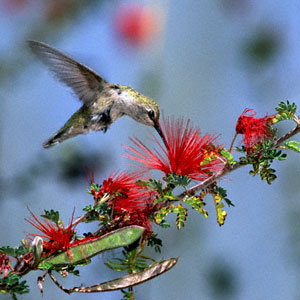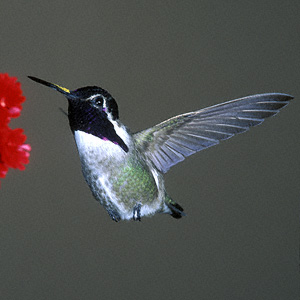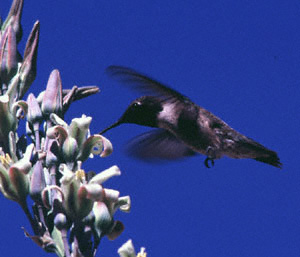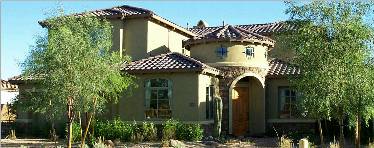Everyone
is fascinated by the nimble, perpetual movement of a hummingbird.
Arizona provides natural habitat for 15 of the 300 different
species of hummingbirds. Creating a habitat for hummingbirds
in your yard can be easy. Many native plants provide a food
source that attract hummingbirds. Hummingbirds seek the nectar
from flowers. Tubular flowers that are red, orange and yellow
provide the nectar that hummingbirds seek.
Plant species that attract hummingbirds include:
Chuparosa
|
Arizona Yellow Bell |
Baja Ruellia |
Fairy Duster |
Desert Milkweed |
Red Yucca |
Turpentine Bush |
Desert Willow |
Cascalote |
Aloes |
Hummingbirds can also be attracted to feeders. There are
two types of feeders, bottle and dish type. Bottle type feeders
utilize an upside down bottle to store the nectar and provide
the nectar through a dish or tube. Dish type feeders are covered
dishes offering multiple bays for the hummingbird to feed.
When choosing a feeder, seek a red feeder and avoid yellow
as they tend to attract bees.
Feeders require maintenance. The nectar should be replaced
weekly during the cooler months and every other day during
the hot summer months. A simple nectar mixture is all that
is required to attract hummingbirds.
There is no need to buy a mix, here’s a recipe for hummingbird
nectar:
4-5 cups of water
1 cup of white sugar
Pour water into a pan, add sugar, bring mixture to boil and
remove from heat as it reaches a boil. Allow the sugar solution
to cool before filling the feeder.
There is no need to add a red dye,as the dye does not attract
hummingbirds, the nectar does.
Hummingbirds that call
Arizona home all year round
Anna's Hummingbird
Calypte anna
Size: 4"
Adult male: rose red to coppery red gorget
with elongated corners, crown the same color, upper breast
gray; tail long, deeply notched, outer tail feathers gray,
blunt-tipped; sings a scratchy, squeaky song from an exposed
perch; immature male similar to female but usually with conspicuous
"five o'clock shadow" in rough outline of adult
gorget, often with many colored feathers by late summer
Female: dull to bright green above, grayish
below, bill medium length and straight, tail long, notched,
with rounded outer feathers banded gray, black and white;
adult female usually has an irregular patch of red or copper
in the center of the throat; call note is a rich chip or chik
Range: resident from California east to far
western Texas, north to southern British Columbia
Status in AZ: common year-round resident
in lower elevations of southern and central Arizona, common
to abundant visitor late summer through early fall in southeastern
mountains,
Habitat: woodland, chaparral, desert scrub,
urban and suburban areas
Nesting season: late winter through spring
Migration: mostly resident, wanders south
and into the mountains in summer and fall– magenta crimson
head, crown and throat with gray belly and green back
Costa's Hummingbird
Calypte costae
Size: 3 1/2"
Adult male: small, violet to purple gorget
with extremely long extensions at corners, crown the same
color, throat, upper breast, and midline of belly white, outer
tail feathers gray, pointed; song is a shrill whee-oo during
elliptical display flights; immature male similar to female
but usually with conspicuous "five o'clock shadow"
in rough outline of adult gorget, often with few to many colored
feathers
Female: small, pale gray below, green above,
occasionally with blackish or iridescent purple spot in center
of throat, bill very short and thin; wings usually reach tip
of short, notched tail, rounded outer tail feathers banded
gray, black and white; call note is a weak, dry tik or tchik
Range: resident in southern California east
to southeastern Arizona, western Mexico, nests north to central
California, southern Nevada and Utah; "wintering"
range extends south and east of nesting range on Pacific slope
of Mexico (late summer-early winter)
Status in AZ: uncommon to common year-round
resident in west and southwest; uncommon to rare spring resident
and late summer visitor in southeastern AZ, February-May.
Habitat: nests in desert scrub, chaparral,
thornscrub, tropical deciduous forest, suburban areas; may
"winter" in oak woodland or conifer forest in mountains
(late summer through early fall)
Nesting season: late winter through spring
Migration: some individuals resident in southern
parts of range; migrants arrive on breeding grounds in late
winter to early spring, may wander to higher elevations in
summer and fall
Black-chinned Hummingbird
Archilochus alexandri
Size: 3 3/4"
Adult male: gorget velvety black with a violet
band at the bottom, upper breast and partial collar white,
outer tail feathers black, pointed; performs a J-shaped display
flight accompanied by a shrill twitter, probably created by
air rushing over the wings and/or tail; immature male similar
to female but usually with conspicuous "five o'clock
shadow" in rough outline of adult gorget, often with
a few colored feathers
Female: pale gray below, dull to moderately
bright green above with a dingy grayish crown, bill long and
slightly decurved, outer tail feathers pointed (rounded in
immature female), banded gray, black and white; call note
is a soft tchew.
Range: nests from central Texas and Oklahoma
west to California, and central Mexico north to southern British
Columbia; winters in western and central Mexico
Status in AZ: common to abundant summer resident
(mostly April-September) in lower to middle elevations
Habitat: oak woodland, streamside forest
and woodland, thickets of mesquite and hackberry in desert
scrub
Nesting season: late spring through summer
Migration: arrives on breeding grounds in
spring, leaves in fall to winter in western and southern Mexico;
occasionally wanders east during migration and winters along
Gulf Coast
Additional
Resources:
The Hummingbird Society http://www.hummingbirdsociety.org/indexnew.asp
The Southeastern Arizona Bird Observatory
http://www.sabo.org/hummers.htm
|



